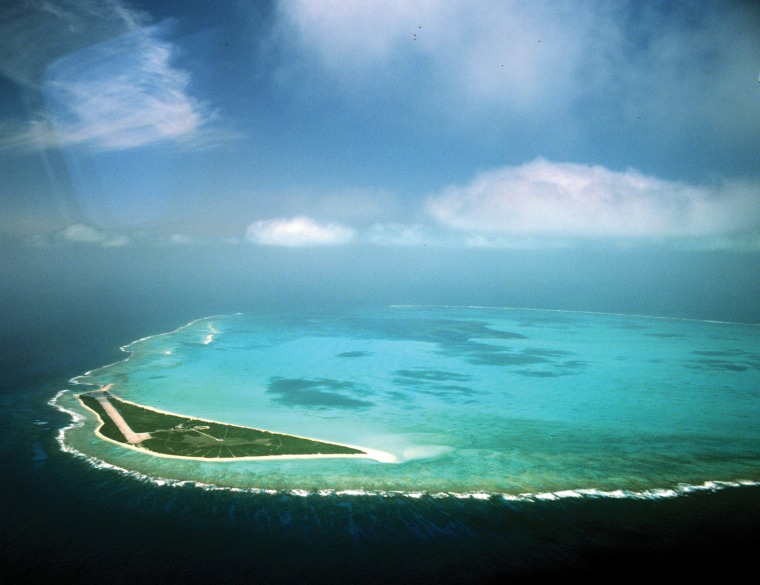The Papahanaumokuakea Marine National Monument — a pristine haven for coral and other marine life, and a treasured site of ancient Hawaiian shrines — has been named a U.N. World Heritage site.
The area northwest of the main Hawaiian islands is the only U.S. location to make the list for both natural and cultural reasons, said monument spokesman Dan Dennison.
The World Heritage Committee of the United Nations Educational, Scientific and Cultural Organization, or UNESCO, made the decision at a meeting in Brazil, Dennison said.
The committee aims to identify sites "considered to be of outstanding value to humanity" and encourages their protection and preservation. There are currently about 890 sites around the world on the list.
The State Department said the monument is the first U.S. site to be added in 15 years. The Grand Canyon, the Statue of Liberty and Hawaii Volcanoes National Park are among 20 U.S. sites already recognized.
No fishing allowed
Papahanaumokuakea consists of remote, mostly uninhabited atolls northwest of the main Hawaiian Islands and the waters surrounding them.
It's home to 69 percent of the coral reefs in U.S. territory. It also hosts 7,000 marine species, a quarter of which are found only in Hawaii. The area is off-limits to fishing, allowing for healthy and abundant populations of sharks, ulua or jackfish, and other marine life.
According to a website about the area, visiting is permitted by the U.S. Fish and Wildlife Service only for scientific, educational and cultural purposes.
At Mokumanamana, a rocky outcrop in the monument about 460 miles northwest of Honolulu, ancient heiau, or shrines, line the top of a ridge running along the spine of the island.
There are similar shrines, with upright stones, in the main Hawaiian islands atop the highest peaks of Maui — Haleakala — and of the Big island — Mauna Loa and Mauna Kea volcanoes.
But Mokumanamana has an unusually high concentration of heiau — at least 34 on just 46 acres.
Haunani Apoliona, chairwoman of the Office of Hawaiian Affairs, said the listing will help preserve Papahanaumokuakea for future generations.
"We are very proud of this historic inscription," Apoliona said in a statement.
The monument is the nation's single largest conservation area and is nearly 100 times larger than Yosemite National Park.
President George W. Bush made the area a national monument in 2006.
21 designations
Delegates from the 193 nations that signed the 1972 World Heritage Convention were in Brazil for 10 days of meetings, which ended Aug. 2.
The Bikini Atoll and a silver trade route in Mexico also were among 21 new places added to the list of World Heritage sites. The additions bring to 911 the total number of sites on the list.
The committee also designated four sites as endangered, including Everglades National Park in Florida. The Everglades, home to 20 endangered species, was previously on the list from 1993 to 2007 because large amounts of water were being diverted to cities. UNESCO said in a statement the park was added again for the same reason.
Other places newly added to the endangered list were the Atsinanana rain forests of Madagascar, where illegal logging and poaching are a threat to rare lemurs; the Bagrati Cathedral and Gelati Monastery in Georgia, and the tombs of Buganda Kings in Uganda. The Galapagos Islands in Ecuador were removed from the endangered list.
Being on the endangered list allows the agency to allocate immediate assistance from the World Heritage Fund.
In a statement, the U.N. Educational, Scientific and Cultural Organization said the Bikini Atoll in the Marshall Islands was designated a World Heritage Site because it symbolizes the "dawn of the nuclear age." Nuclear bomb tests conducted there in the 1940s and '50s also had "major consequences" on the geology and environment of the atoll, UNESCO said.
Also designated a World Heritage site was the Camino Real de Tierra Adentro, a trade route from Mexico north to the U.S. that was used from the 16th to 19th centuries for transporting silver.
Other cultural attractions designated as World Heritage sites during the UNESCO committee meeting were the Imperial Citadel of Thang Long-Hanoi in Vietnam, built in the 11th century; historic monuments of Dengfeng in China; the archaeological site Sarazm in Tajikistan; the Episcopal city of Albi in France; a 17th-century canal ring in Amsterdam; Sao Francisco Square in Sao Cristovao, Brazil, which dates to the 16th century; the prehistoric caves of Yagul and Mitla in Oaxaca, Mexico; the Turaif District in Saudi Arabia; the Australian Convict penal sites; the Jantar Mantar astronomical observation site in India; a shrine complex in Ardabil in Iran; the Tabriz historic bazaar complex, also in Iran; and historic villages of Hahoe and Yangdong in South Korea.
Five natural sites added to the list were Sri Lanka's biodiverse highlands, which UNESCO described as being home to "an extraordinary range of flora and fauna, including several endangered species"; China Danxia, in China, where UNESCO said that red cliffs, waterfalls and forests are home to 400 rare or threatened species of plants and animals; the Phoenix Islands Protected Area in Kiribati, in the South Pacific, one of the world's largest coral archipelago ecosystems; Reunion Island, comprised of two volcanic peaks and rugged terrain in the Indian Ocean; and the Putorana Plateau in Russian, north of the Arctic Circle in Siberia.
